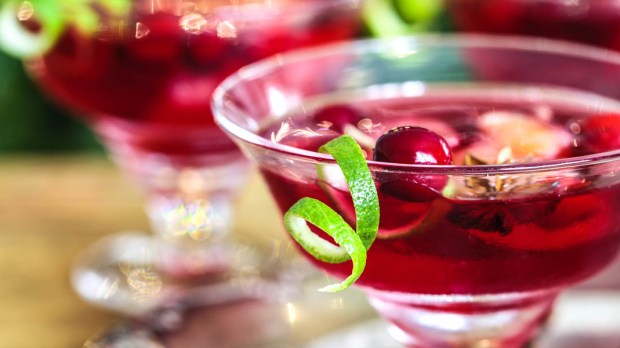Drinking with Saint Nick: Christmas Cocktails for Sinners and Saints
by Michael P. Foley
Regnery History, 200 pp., $19.99
“Moderation is not only the morally responsible thing to do, it is also the more pleasant,” says Michael Foley. Speak for yourself, pal! As someone who attempted 30 shots on his 30th birthday (I made it to 9) and once paid $25 for a four-hour all-you-can-drink extravaganza, I can tell you those moments were, well, special. Sure it wasn’t morally responsible, and the aftermath was far from pleasant, but that’s why we pray to Bibiana, the patron saint of hangovers.
This I learned from Foley’s latest book, Drinking with Saint Nick: Christmas Cocktails for Sinners and Saints, a fitting sequel to his popular Drinking with the Saints. Bibiana was a 4th century Roman martyr whose garden supposedly had herbs that cured headaches and epilepsy. Foley urges us to raise a glass to the martyr on her feast day, December 2, and to pray that “through the intercession of St. Bibiana, may we never need the intercession of St. Bibiana.”
In fact, Foley has a drink recommendation for practically every day of the Advent-Christmas season, stretching from the the First Sunday of Advent right through to the Epiphany and beyond. So a drink every day for 40 days? Maybe I don’t disagree with his view on moderation after all.
Foley is upfront about his “strained” efforts to tie saints and holy days to cocktails. We don’t know what libations Lazarus enjoyed but Foley hilariously recommends Corpse Reviver #2 (a blend of gin, Cointreau, Lillet Blanc, lemon juice, and pastis). On the other hand his suggestion we drink a Bloody Mary on the Feast of the Circumcision doesn’t quite, ahem, cut it for me. Likewise, to celebrate the Feast of St. Sylvester (December 31), he offers us Godly Prosperity, which calls for a liquor with gold flakes. But there is no way in hell I am going near Goldschläger.
Many of the drink recipes are quite approachable, some even effortless—the Benedict Arnold requires but Scotch and Benedictine liqueur on the rocks. (Foley assigns this drink to St. Elizabeth Ann Seton, whose family members were Tories.) Most of the ingredients are easily obtainable from your local liquor store, and alternatives are provided in case you can’t find, say, feni, “a brandy made in Goa from cashew apples.”
Other concoctions are downright daunting: Christmas Punch, for one, consists of claret, red wine, pineapple slice, rum, lemon and orange juices, water, sugar, lemon and orange rinds, whole oranges, maraschino cherries, champagne, one cinnamon stick, and one vanilla bean.
The precursor to Christmas Punch is the Wassail (I’ve wondered about this word for years but never bothered to ask). Foley, a professor of patristics at Baylor University, informs us it was “a medieval combination of hot ale or mead, roasted apples, eggs, nutmeg, and floating pieces of toast.” The word is derived from the Old Saxon Was haile, meaning “Your health.”
Drinking with Saint Nick is divided into five parts: Advent, the Golden Nights (there’s a great explanation of the O Antiphons), the Twelve Days of Christmas—both calendar and song—and “Epiphany and the Time Thereafter.” Foley concedes there are numerous theories on the origin of “The Twelve Days of Christmas.” “There could be a Catholic connection,” he writes. But why be particular? It’s the holidays, after all, have another drink.
And even after the holidays, there are still great drinks to be had. Commemorate Plough Monday (the Monday after Epiphany) with a Snow Plow: Bailey’s Irish cream, coconut rum, crème de cacao, hot chocolate, sprinkles, and whipped cream. It sure beats the alternative, which in England apparently involves “blackening one’s face to disguise one’s identity, dragging around a decorated plough, and shouting, ‘Penny for the ploughboys!’” Seriously, do not attempt that.
Besides all the theological explanations offered by Foley, there are many colorful asides about the saints whose feast days fill the season. Many you know—St. Edmund Campion (December 1), St. John the Evangelist (December 27), St. Francis Xavier (December 3), St. Nicholas (Decemeber 6)—but also a good many you might not. St. Nino (December 15) brought Christianity to the region of Georgia. St. Eusebius of Vercelli (December 16) battled against the Arian heresy. The unfortunately named St. Gorgonia (December 9) came from a family of saints (both parents and two of her brothers).
And then there’s St. Servulus (December 23), who lived in 6th century Rome. “Servulus was afflicted from birth with a palsy that left him completely paralyzed, unable to use his arms or legs or to sit up or turn over on his side without help,” writes Foley. He was also illiterate but had others read to him the Psalms and the Gospels. Foley says it was Pope Gregory the Great who noted that Servulus “thanked the Lord for his affliction, for it allowed him ‘to be a victim associated with the pains and sufferings of Jesus Christ.’” For a wonderfully irreverent book on drinking, it’s a sobering thought.

